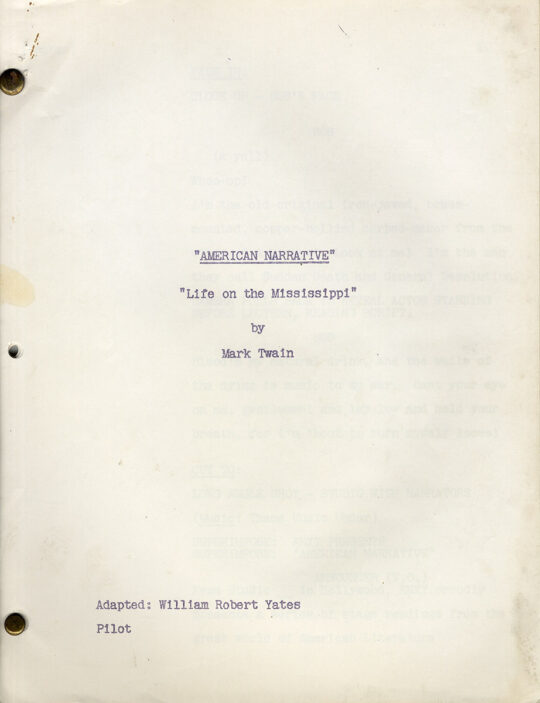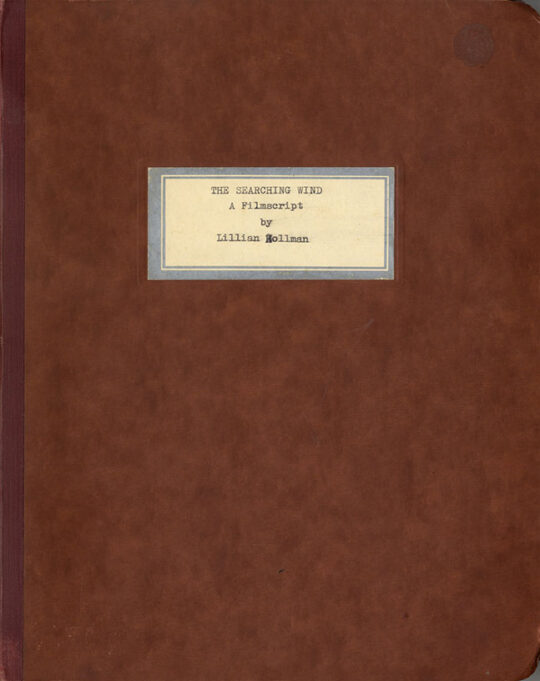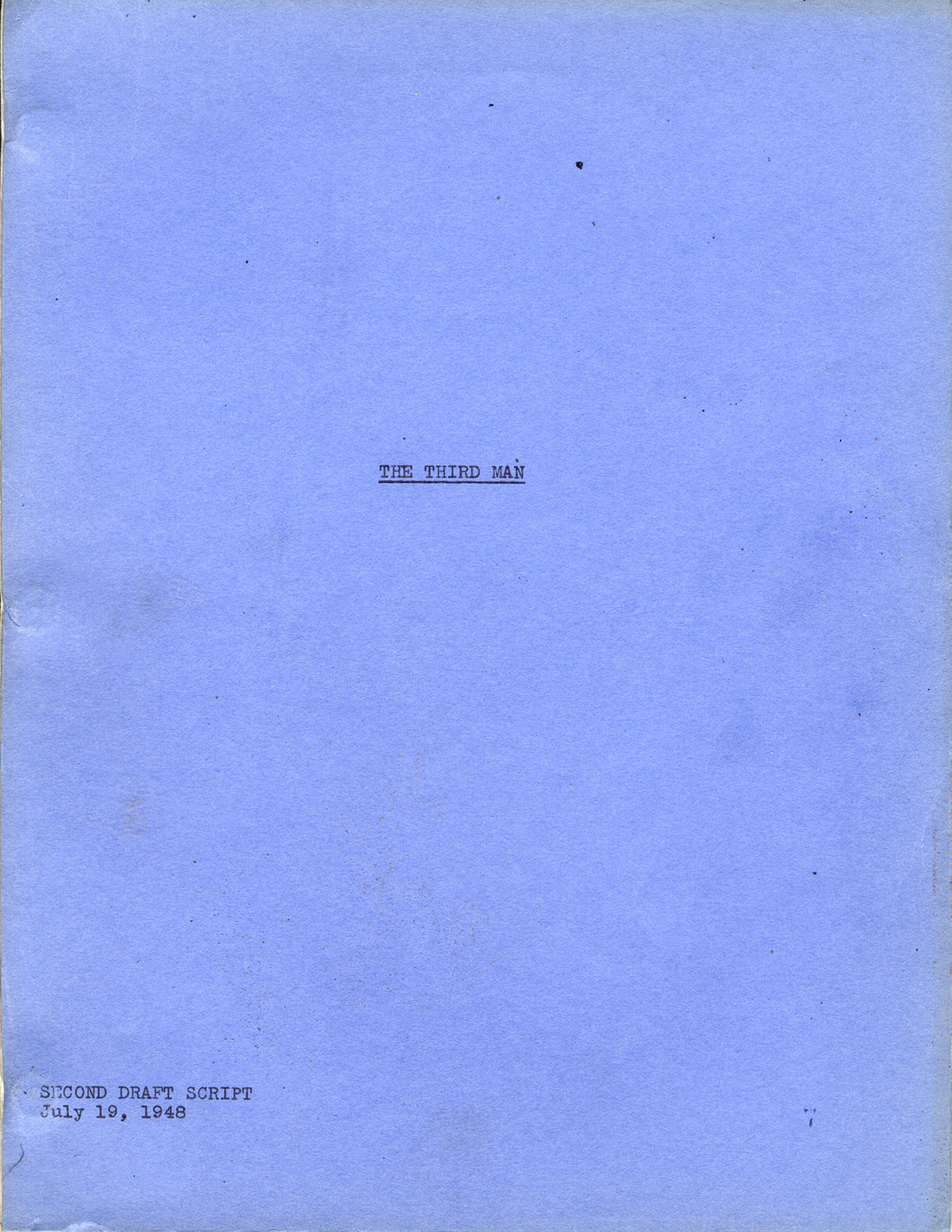THIRD MAN, THE (1949) Second Draft script, Jul 19, 1948 by Graham Greene
Graham Greene (screenwriter), Carol Reed (director) Hollywood: David Selznick Productions, 1949. Vintage original film script, USA. Quarto, printed wrappers, brad bound, mimeograph, 118 pp., JUST ABOUT FINE, in a custom quarter morocco clamshell case (slightly rubbed).
The crown jewel of British film noirs released during the classic noir era, THE THIRD MAN was based on an original screenplay by Graham Greene (1904-1991), written on location in post-war Vienna in close collaboration with producer/director Carol Reed (1906-1976), in tandem with a novella by Greene of the same name.
Though Greene was known primarily as a novelist, he was also a man of the cinema. He was a distinguished film critic and, prior to THE THIRD MAN, eleven of his novels or stories had been made into movies, sometimes with scenarios by Greene himself, including The Green Cockatoo (William Cameron Menzies, 1937), This Gun For Hire (Frank Tuttle, 1942), Went the Day Well? (Alberto Cavalcanti, 1942), Ministry of Fear (Fritz Lang, 1944), The Fugitive (John Ford, 1947), Brighton Rock (John Boulting, 1947), and The Fallen Idol (Carol Reed, 1948). In 1999, the British Film Institute voted THE THIRD MAN the greatest British movie of all time.
Director Reed and his cinematographer, Robert Krasker, took magnificent advantage of THE THIRD MAN’s post-war Viennese locations, just as they had done with the Belfast locations of Odd Man Out filmed two years earlier. The decision to shoot most of THE THIRD MAN on actual locations, with non-actors as extras, links it with the Italian neo-realism of its era. The fact that “the dark city,” in this case Vienna, is a major character in the story is one of the things that identifies THE THIRD MAN as a film noir.
Greene’s second draft screenplay contains most of the brilliant dialogue and virtually all of the narrative that was eventually shot. Yet there were a number of significant changes made between this draft and the completed film that went beyond mere polishing.
Some of the changes were the consequence of casting decisions. It was co-producer David O. Selznick who insisted that Joseph Cotten and Alida Valli – both of whom were under contract to Selznick – be cast as the male and female leads. Selznick also secured his friend, Orson Welles, for the key role of antagonist Harry Lime. As a result, the protagonist, a British writer of pulp Westerns named Rollo Martins in Greene’s screenplay, became an American writer of pulp Westerns named Holly Martins in the film. Harry Lime also became an American, and the nationality of Alida Valli’s character, Anna Schmidt, was changed from Estonian to Czech. Changing the nationality of the leading man from British to American added a whole extra dimension to the film, turning it into a story of American naiveté confronting European sophistication and corruption in the manner of a Henry James novel like Daisy Miller or The Golden Bowl. (The name, Harry Lime, was a writer’s in-joke, since lime is, in fact, a shade of “Greene.”)
Director Reed changed both the beginning and the end of Greene’s screenplay. Greene’s screenplay opens with a shot of Major Callahan, head of British Police Services (played in the film by Trevor Howard), standing in front of a filing cabinet and setting up the story (“You want to hear about the case of Harry Lime. It’s an ugly story if you leave out the girl . . . .”). The film opens with a montage of images of bombed-out post-war Vienna while an unidentified narrator describes how the city was divided among the four powers – the Russian, the British, the American, and the French. The voice of the narrator is that of Reed himself, not so subtly establishing the movie as a film d’auteur, and its point of view as that of the director (or his avatar).
At the end of the screenplay (and Greene’s novella), in the aftermath of Harry Lime’s funeral, Holly Martins and the girl, Anna Schmidt, join happily together:
In the long street lined with monumental masons the two little figures slowly come towards each other.
FADE OUT.
However, at the end of the movie (Reed’s idea, supported by co-producers Selznick and Korda, but protested by Greene), Anna walks down the tree-lined street past Martins, not even looking back.
Two more of THE THIRD MAN’s most memorable aspects – the film’s omnipresent zither music and its distinctive tilted camera angles – were Reed’s contributions. Apparently, while Reed was in Vienna working on the screenplay with Greene, he heard the zither player, Anton Karas, performing at a social function, and Reed was so fascinated by the sound that he sat there all night listening to it. Later, he invited Karas to a hotel room to record him, and Karas’s zither music was eventually used to underscore the entire film (with the notable exception of the sewer sequence where we hear only echoing footsteps, dripping water, gunshots, voices, and other “natural” sounds). We see and hear the vibrating strings of Karas’s zither under the movie’s opening credits.
The tilted camera angles are a visual expression of one of the director Reed’s principal themes – equilibrium, and the fear of its loss. Reed’s films are filled with imagery relating to this theme, for example, the treacherous staircase in The Fallen Idol (even the title of The Fallen Idol suggests a loss of balance). In Outcast of the Islands (1952), perhaps Reed’s clearest statement of the theme, it is expressed through the imagery of Captain Lingard (Ralph Richardson) steering his ship carefully through clashing rocks, and in the horrible fate of the portly Almayer (Robert Morley) suspended from a rope and pummeled back and forth by the island’s natives. James Mason’s character in Odd Man Out (1947) is shot by a bullet in the movie’s first act, and throughout the rest of the film is barely capable of holding himself upright. Trapeze (1956) is self-evidently another film about balance and the fear of its loss, with Reed’s signature camera tilts transposed to color and widescreen.
Even Reed’s later movies reiterate this theme. The Agony and the Ecstasy (1965) is about an artist – Michelangelo – painting while suspended from a ceiling. In Oliver! (1968), the villainous Bill Sykes (Oliver Reed) meets his doom by falling off a roof. In THE THIRD MAN, the theme of precariousness is expressed most overtly in the scene aboard the Ferris wheel – the viewer keeps wondering if Harry is going to shove Holly out of the dangling car.
THE THIRD MAN is also incidentally one of the clearest expressions of another recurring Reed theme – the fugitive in the dark city. (See also, Odd Man Out and The Man Between.) Reed was celebrated for his work with children and animals. (His 1955 film, A Kid For Two Farthings, is about a London city boy and his pet goat.) Hence, it is no surprise that children and animals play a more prominent role in the movie of THE THIRD MAN than they do in Greene’s screenplay.
The role of the little German-speaking boy, Hansel, is built up in the film – in the movie he carries a ball which he rolls into one scene preceding his entrance, and it is he, with his little piping voice, who provokes a street crowd, gathered around the body of a murdered porter, to believe that Martins is the murderer.
In another Reedian touch, one of Greene’s villains, the Baron Kurtz, is always seen carrying a little dog. Most memorable of all is Harry Lime’s cat (not mentioned in the screenplay). When Martins tries to play with the cat in Anna’s apartment, it ignores him. “He only liked Harry,” she says. Then, a few moments later, the same cat strolls down a street and approaches a man standing in a shadowy alcove, playing affectionately with the man’s shoelaces. That’s how Reed reveals that the man standing in the shadows is Harry. There is a parrot (or cockatoo) in both the screenplay and the film, but in the film it bites Martins.
Some of Greene’s sharpest dialogue occurs in the scene between Martins (Joseph Cotton) and Lime (Orson Welles) on the Ferris wheel, for example:
HARRY
Look down there. (He points through the window at the people moving like black flies at the base of the wheel.) Would you really feel any pity if one of those dots stopped moving – forever? If I said you can have twenty thousand pounds for every dot that stops, would you really, old man, tell me to keep my money – without hesitation? Or would you calculate how many dots you could afford to spare? Free of income tax, old man. Free of income tax.
However, the scene’s most famous speech, Lime’s monologue concerning the Borgias, the Swiss, and the cuckoo clock, was apparently improvised by Welles. In a movie that is dense with allusions to other movies THE THIRD MAN’s scene in the Ferris wheel with Welles as Harry Lime and Joseph Cotton as his disillusioned best friend, Holly Martins, inevitably resonates with the viewer’s memory of Welles as Charles Foster Kane confronted by Joseph Cotton as his disillusioned best friend, Jed Leland, following the failed gubernatorial campaign in Welles’s Citizen Kane. The way the two actors play off one another, their voices, their feelings, the overlapping of their dialogue is remarkably similar. In both scenes, you feel a deep sense of emotional history shared by the two men, with Welles’s character turning on the charm and Cotten’s character no longer buying it.
The scene in THE THIRD MAN – its comic highlight – where writer of pulp Westerns, Holly Martins, is corralled (pun intentional) into answering the questions of a highbrow British literary society consciously recalls a similar scene in Hitchcock’s The 39 Steps (1935) where Robert Donat’s character is mistaken for the introductory speaker at a political meeting and has to improvise his way out of the situation. (It’s also screenwriter Greene’s commentary on highbrow art vs. lowbrow art.)
THE THIRD MAN’s images of the little boy with the ball and the old man selling balloons recall similar images in Fritz Lang’s M (1931). In the late ’40s/early ’50s, Carol Reed directed a series of four films – Odd Man Out (1947), The Fallen Idol (1948), THE THIRD MAN (1949), and Outcast of the Islands (1952) – which many film aficionados now consider masterpieces. Two of them were written by Greene. After that creative peak, Reed would continue to direct good movies – among them, Our Man In Havana (1959), from a novel and screenplay by Graham Greene, and the musical Oliver! (1968), which earned Reed the Academy Award for Best Director – but, alas, no more masterpieces. Harry Lime as Archetype I suspect the principal reason for THE THIRD MAN’s lasting cultural impact was the archetypal nature of the character, Harry Lime. (The movie is clearly treasured by more viewers than any of Reed’s other films and, for many, Harry Lime was Orson Welles’s greatest role.)
Greene was considered a Roman Catholic writer, and Catholicism plays a prominent role in many of his more “serious” works, e.g., Brighton Rock, The Power and the Glory, The Heart of the Matter, and The End of the Affair. Superficially, THE THIRD MAN would appear to be one of Greene’s least Catholic works. (A line delivered by Martins to Lime in the screenplay, “You used to be a Catholic,” was changed in the movie to “You used to believe in God.”)
Yet the fundamental idea animating Greene’s screenplay for THE THIRD MAN is one of the basic tenets of Catholicism, the Resurrection. It began with a single sentence written by Greene when he initially proposed his idea of THE THIRD MAN to producer Alexander Korda: “I had paid my last farewell to Harry a week ago, when his coffin was lowered into the frozen February ground, so that it was with incredulity that I saw him pass by, without a sign of recognition, among the host of strangers in the Strand.”
At that point, Greene didn’t know who Harry was, or what his story would be, other than its post-war Vienna setting. But that tiny germ of an idea – the apparent resurrection of a man thought to be dead – was the seed from which everything else grew.
In our Western culture, the two most renowned archetypes of the resurrected dead man are Dracula and Jesus Christ. THE THIRD MAN’s Harry Lime combines aspects of both. Orson Welles, the actor who played Harry Lime, had a long association with Dracula. Dracula was the first radio production of Orson Welles’s Mercury Theater of the Air, premiering on July 11, 1938, with Orson himself narrating and playing the role of the vampire count.
One can see the visual influence of Tod Browning’s 1931 film of Dracula in Welles’s Citizen Kane, where the elephantine spaces of Kane’s mansion, Xanadu, recall the unbelievably spacious rooms of Dracula’s gothic castle as directed by Browning and photographed by Karl Freund. If Orson Welles as Harry Lime is THE THIRD MAN’s Dracula, then Joseph Cotten as Holly Martins is his blindly loyal Renfield, betraying him at the end, as Dwight Frye’s Renfield betrays Bela Lugosi’s Dracula at the conclusion of the 1931 film, and Alida Valli as Anna Schmidt is one of Dracula’s brides, never free from the vampire’s hypnotic thrall. Harry’s penicillin racket, like Dracula’s vampirism, leaves a trail of dead or dying victims – Trevor Howard as Major Callahan would be THE THIRD MAN’s Van Helsing – and, like Dracula, Harry is associated with a Plutonian underworld, the Viennese sewers.
THE THIRD MAN’s climactic scene of Major Callahan, Holly, et al. traipsing around the sewers after Lime is not unlike the final scene of Browning’s Dracula with Van Helsing and Jonathan Harker searching the dusky basement of Carfax Abbey for Dracula’s coffin. Harry, seen in glimpses after his “death” by his devoted followers, Holly and Anna, is also like a dark version of the resurrected Christ.
Even Greene’s title, THE THIRD MAN, is apparently an oblique reference to Christ, deriving, according to Robb White’s BFI monograph, from the passage in Luke 24:13-15 which describes the resurrected Jesus walking alongside two of his disciples, and from T.S. Eliot’s lines in The Wasteland which invoke that same Biblical passage:
Who is the third who walks always beside you?
When I count, there are only you and I together
But when I look ahead up the white road
There is always another one walking beside you
If Harry, viewed through the lens of Greene’s perverse Catholicism, is some kind of dark Jesus, then Holly is his betraying Judas, and Anna is his Magdalene. Both Harry and Jesus are associated (like Dracula) with the underworld. Harry hides in the shadows of the Viennese sewers, and Jesus is said to have visited Hell between his crucifixion and his resurrection on the third day. The film intentionally recalls Christ’s crucifixion in the iconic image of Orson Welles as the hunted Lime, standing in the sewers with his arms outstretched shortly before his second (real) death. THE THIRD MAN seems to say that if Christ were to actually return, we would only crucify him a second time.
Thanks mainly to the archetypal power of Harry Lime, THE THIRD MAN transcends its status as a classic of post-war noir and achieves the level of myth.
Out of stock
Related products
-

Sidney Lumet (director) PRINCE OF THE CITY (Jan 1980) Final Draft film script
$950.00 Add to cart -

John Singleton (writer, director) HIGHER LEARNING (Jan 26, 1994) Rainbow film script
$500.00 Add to cart -

Mark Twain (source) LIFE ON THE MISSISSIPPI (ca. 1956) TV script adapted by William Robert Yates
$300.00 Add to cart -

SEARCHING WIND, THE (Nov 7, 1946) Final White script by Lillian Hellman
$1,500.00 Add to cart




